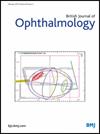Longitudinal variability outcomes of frontloaded visual field testing
IF 3.5
2区 医学
Q1 OPHTHALMOLOGY
引用次数: 0
Abstract
Aim To assess if performing two visual field (VF) tests per eye on the same visit (frontloading) can increase perimetric data and decrease longitudinal variability compared with one test per eye. Methods A prospective longitudinal study of 498 healthy, glaucoma suspects and glaucomatous eyes of 333 subjects. Two intra-visit SITA-Faster VF tests (T1 and T2) per eye were performed on each visit for five consecutive visits. Rates of change and longitudinal variability of global (mean deviation) and pointwise sensitivity were compared between two approaches using linear mixed-effects models: use of the mean of T1 and T2 sensitivity values (frontloaded approach) versus the use of T1 sensitivity values alone (non-frontloaded approach). Results The mean duration of follow-up was 2.0 (SD 0.5) years. The mean rate of global sensitivity progression was similar in both frontloaded and non-frontloaded approaches (−0.12 vs −0.07 dB/year, respectively, p=0.3). The residual SD (1.19 vs 1.36, p<0.001) and mean absolute residuals (MARs) (0.69 vs 0.78, p<0.001) were significantly smaller in the frontloaded approach, indicating less variability. The mean rate of pointwise sensitivity change was significantly more negative in the frontloaded approach (−0.18 vs −0.14 dB/year, p<0.001), with significantly smaller MAR (1.24 vs 1.53, p<0.001). The frontloaded approach still displayed significantly lower variability even when unreliable tests (false positives >15%) were excluded. Conclusion Frontloading VF tests on the same visit may help clinicians meet the recommendations of minimum test frequency in glaucoma and can decrease the longitudinal variability of global and pointwise sensitivity changes. Data are available upon reasonable request. Not applicable.前负荷视野测试的纵向变异性结果
目的评估在同一次就诊(前负荷)中每只眼睛进行两次视野(VF)检查与每只眼睛进行一次检查相比,是否可以增加视野数据并减少纵向变异性。方法对498只健康眼、疑似青光眼和青光眼333只进行前瞻性纵向研究。在连续5次就诊中,每次就诊均对每只眼睛进行2次SITA-Faster VF测试(T1和T2)。使用线性混合效应模型比较两种方法的整体(平均偏差)和点向敏感性的变化率和纵向变异率:使用T1和T2敏感性值的平均值(前负荷方法)与单独使用T1敏感性值(非前负荷方法)。结果随访时间平均为2.0年(SD 0.5)。前负荷和非前负荷方法的平均总体敏感性进展率相似(分别为- 0.12和- 0.07 dB/年,p=0.3)。排除残差SD (1.19 vs 1.36, p15%)。结论同一次就诊前载VF检测可满足青光眼患者最低检测频率的建议,并可降低整体和点向灵敏度变化的纵向变异性。如有合理要求,可提供资料。不适用。
本文章由计算机程序翻译,如有差异,请以英文原文为准。
求助全文
约1分钟内获得全文
求助全文
来源期刊
CiteScore
10.30
自引率
2.40%
发文量
213
审稿时长
3-6 weeks
期刊介绍:
The British Journal of Ophthalmology (BJO) is an international peer-reviewed journal for ophthalmologists and visual science specialists. BJO publishes clinical investigations, clinical observations, and clinically relevant laboratory investigations related to ophthalmology. It also provides major reviews and also publishes manuscripts covering regional issues in a global context.

 求助内容:
求助内容: 应助结果提醒方式:
应助结果提醒方式:


